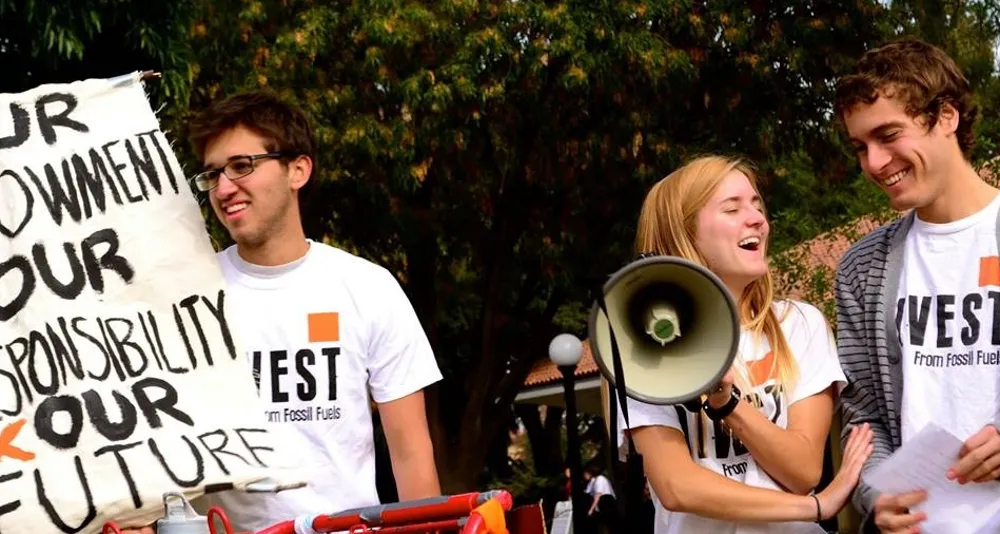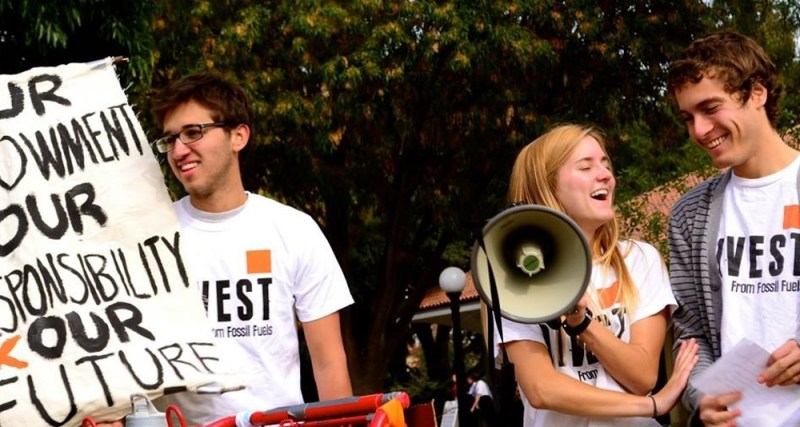In this year’s ASSU elections, voters approved a ballot initiative to divest Stanford’s endowment from fossil fuels with 78 percent of votes in favor, setting in motion a process that could eventually lead to the Board of Trustees.
In the run-up to the vote, Fossil Free Stanford — the student group that championed the ballot initiative for divestment — led a large campaign called Divestment Week.

Divestment Week featured a number of rallies, culminating in the largest one on April 11, the final day of the election. Nearly 60 students and alumni marched from White Plaza to University President John Hennessy’s office and delivered over 200 handwritten letters from alumni in support of divestment. Professor of Biology Paul Ehrlich spoke at the rally along with several student supporters and alumni.
Leading up to the vote, most of Fossil Free Stanford’s efforts were concentrated on outreach.
“During the lead up to the election our primary goal was to talk to every single Stanford student we could get our hands on,” said Michael Penuelas ’15, a student organizer of the Fossil Free movement. “Over the week we talked to hundreds and hundreds of different students, bringing the total in this movement so far up to thousands of Stanford undergraduates in particular.”
While the divestment initiative had overwhelming student support, the divestment petition must still make its way through several advisory committees before the Board of Trustees will vote on it. Fossil Free Stanford has had minimal contact with the board members thus far, and according to Yari Greaney ’15, a student organizer of the Fossil Free movement, the organization is “waiting until we have formally reached their plate before we start dialogue with them.”
Fossil Free Stanford has worked, however, with the Advisory Panel on Investment Responsibility and Licensing (APIRL) for over a year. APIRL has researched the request to divest Stanford from fossil fuels and, according to Greaney, is on target to make a recommendation to the Board of Trustees by the end of this academic year.
“This is really, really powerful for our movement and we are really excited to see what the administration will do in response to the overwhelming student support for the ballot initiative,” Greaney said. “It is our hope that the board will commit to divesting from the fossil fuel industry come fall.”
In his annual address to the Academic Council on Thursday, Hennessy addressed fossil fuel divestment during the question-and-answer period. He noted that the divestment petition must make its way through several advisory committees before the Board of Trustees will vote on it and that a decision will likely be made at the Trustees’ June meeting or their meeting next fall.
“We have a set of policies around endowment and how we think about investment responsibility and I think those policies chart a set of goals with respect to balancing the core goal of the endowment — which is to draw revenue to run the University — against issues of social responsibility that the University has,” Hennessy said. “There are the core values that we try to respect and organize and how those will align with long-term sustainability goals is something I think we all have to watch and be aware of.”
Penuelas said that he hopes that the recommendation from the APIRL will help push the Board towards supporting divestment.
“While revenue generation is the primary goal of the endowment, there is this formal mechanism that the Stanford administration respects enormously which is put in place directly to make sure that those investment decisions are still congruent with Stanford’s founding principles and values, [because] those definitely need to go hand in hand and be considered together, because where that money goes is just as important,” Penuelas said.
Moving forward, Fossil Free Stanford plans to continue its alumni letter-writing campaign and is also in the process of initiating a Graduate Student Council resolution that would express support for divestment. The Undergraduate Senate passed a similar measure last year. Additionally, Penuelas noted that a letter that is currently being circulated has garnered the signatures of over 50 senior faculty members.
“The idea is to engage all demographics of Stanford to prove widespread support, which the undergraduate students proved resoundingly this week,” Penuelas said. “We are hoping that more of those other demographics manage to do the same by the end of this spring.”
“It’s important to remember that divestment is a strategy and a safe global climate is the goal. This is just one strategy in a mix of many strategies,” Greaney said.
Contact Lucy Svoboda at [email protected].
